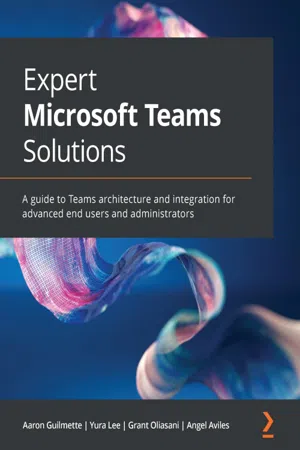
- 628 pages
- English
- ePUB (mobile friendly)
- Available on iOS & Android
Expert Microsoft Teams Solutions
About this book
Get expert-led advice on how to make the most of underused Teams features, find answers to questions that are rarely covered elsewhere, and explore tasks that customers frequently rely on Microsoft Partners to accomplishKey Features• Deliver a better Teams experience with the help of Microsoft's technical specialists• Explore advanced Teams capabilities such as voice, governance, and Power Platform integration• Get to grips with planning resources for voice integration in TeamsBook DescriptionMicrosoft Teams is an invaluable tool that can integrate various Microsoft products into a single convenient hub. But making the most of it often requires expert help and hours spent on calls and live chats. If you'd rather have all the information you need to make the most of Teams in one place, then this book is for you.Written by two Microsoft technical specialists who have spent years helping clients find the best way to utilize Teams, this book will help you understand Teams as a whole — from architecture and collaboration through to apps and voice. You'll study the platform from the perspective of the end user as well as the administrator, gaining insights and learning from real-life examples.You'll tackle adopting, implementing, and administering Teams efficiently, which will help you realize its full potential. From setup and deployment to modernizing your organization's chat and voice infrastructure, you'll get plenty of useful and actionable tips as you progress.By the end of your journey through this book, you'll be able to design and implement the most important and exciting aspects of Microsoft Teams help your organization work more efficiently.What you will learn• Gain a clear understanding of Microsoft Teams architecture and deployment concepts• Become well-versed with advanced Teams voice capabilities• Explore best practices to extend the Teams experience to various apps through collaboration• Focus on how to conduct effective meetings, including ad hoc, scheduled, channel, and live events• Integrate Power Apps and Power Automate with Microsoft Teams• Understand key governance and security concepts in administering Microsoft TeamsWho this book is forThis book is for intermediate-level and experienced Microsoft Teams IT professionals, as well as administrators looking to implement Teams. To get the most of this book, you'll need intermediate-level knowledge of the platform.
Frequently asked questions
- Essential is ideal for learners and professionals who enjoy exploring a wide range of subjects. Access the Essential Library with 800,000+ trusted titles and best-sellers across business, personal growth, and the humanities. Includes unlimited reading time and Standard Read Aloud voice.
- Complete: Perfect for advanced learners and researchers needing full, unrestricted access. Unlock 1.4M+ books across hundreds of subjects, including academic and specialized titles. The Complete Plan also includes advanced features like Premium Read Aloud and Research Assistant.
Please note we cannot support devices running on iOS 13 and Android 7 or earlier. Learn more about using the app.
Information
Part 1: Collaboration and Apps
- Chapter 1, Taking a Tour of Microsoft Teams
- Chapter 2, Approvals
- Chapter 3, Task Management in Teams
- Chapter 4, Bookings in Teams
Chapter 1: Taking a Tour of Microsoft Teams
- Architecture
- User interface
Architecture



- Identity
- Messaging
- Files
- Voicemail
- Recording
- Calendars and meetings
- Contacts
Identity
Table of contents
- Expert Microsoft Teams Solutions
- Contributors
- Preface
- Part 1: Collaboration and Apps
- Chapter 1: Taking a Tour of Microsoft Teams
- Chapter 2: Approvals
- Chapter 3: Task Management in Teams
- Chapter 4: Bookings in Teams
- Part 2: Meetings
- Chapter 5: Conducting Teams Meetings
- Chapter 6: Microsoft Teams Rooms
- Chapter 7: Live Events
- Part 3: Bots and Development
- Chapter 8: Power Apps in Teams
- Chapter 9: Workflow Integration
- Chapter 10: Power Virtual Agents in Teams
- Part 4: Voice
- Chapter 11: Planning for Teams Phone
- Chapter 12: Deploying Teams Phone
- Chapter 13: Configuring Advanced Teams Phone Features
- Chapter 14: Teams Devices
- Part 5: Administration
- Chapter 15: Planning and Adoption
- Chapter 16: Governance
- Chapter 17: Integration with Exchange Server
- Chapter 18: Security and Data Protection
- Chapter 19: Reporting in Teams
- Appendix A: Direct Routing and Operator Connect
- Other Books You May Enjoy